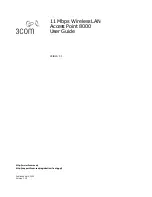
Glossary
GL-5
Cisco Aironet 1550 Series Outdoor Mesh Access Point Hardware Installation Guide
OL-24247-01
P
packet
A basic message unit for communication across a network. A packet usually includes routing
information, data, and sometimes error detection information.
Q
QPSK
Quadruple phase shift keying is a
modulation technique used by IEEE
802.11b-compliant wireless LANs for transmission at 2 Mb/s.
R
range
A linear measure of the distance that a transmitter can send a signal.
RAP
Root Access Point
receiver sensitivity
A measurement of the weakest signal a receiver can receive and still correctly
translate it into data.
RF
Radio frequency. A generic term for radio-based technology.
roaming
A feature of some access points that allows users to move through a facility
while maintaining an unbroken connection to the LAN.
RP-TNC
A connector type unique to Cisco Aironet radios and antennas. Part 15.203 of
the FCC rules covering spread spectrum devices limits the types of antennas that
may be used with transmission equipment. In compliance with this rule, Cisco
Aironet, like all other wireless LAN providers, equips its radios and antennas
with a unique connector to prevent attachment of non-approved antennas to
radios.
S
spread spectrum
A radio transmission technology that spreads the user information over a much
wider bandwidth than otherwise required in order to gain benefits such as
improved interference tolerance and unlicensed operation.
SSID
Service set identifier (also referred to as Radio Network Name). A unique
identifier used to identify a radio network and which stations must use to be able
to communicate with each other or to an access point. The SSID can be any
alphanumeric entry up to a maximum of 32 characters.


































